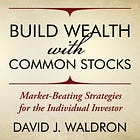Course Module 109: Quantifying a Stock's Equity Bond Rate
Comparing shareholder yields to the prevailing rate on the 10-Year Treasury Note

Summary
The returns to shareholders by a publicly traded company are a leading barometer of the worthiness of owning a slice of the business.
As shareholders, we deserve a compounding return or yield from each leg of the earnings vertical.
Average the earnings, free cash flow, and dividend yields and compare them to the Ten-Year Treasury rate in determining the equity bond rate of the individual stock.
Common shares underperforming the Ten-Year Treasury become unworthy equity candidates for thoughtful buy-and-hold investors.
Quality Value Investing Research Report’s shareholder yields section uncovers the equity bond rate of the company’s common shares. It aims to quantify the yields on earnings, free cash flow, and dividends to measure how the targeted stock compares to the prevailing rate on the 10-Year Treasury benchmark note.
Course Module 109 Syllabus
Subject matter objective: QVI’s proprietary equity bond rate modeling tells us whether a stock is worthy of the assumed higher-risk profile compared to the perceived safer intermediate-term government issue. This module introduces an alternative yield methodology toward outperforming Treasury rates.
Returns to shareholders are a leading barometer of the worthiness of owning a slice of the business.
Earnings yield is the annualized trailing earnings per share divided by the stock’s closing price.
Free cash flow yield shows how much a business generates in free cash flow each year per common share relative to the stock price.
Dividend yield indicates how much a company paid out in dividends for the previous twelve months relative to the current share price.
Why the yield on the cost basis is an ideal alternative to forward high-yield dividend investing.
How to average the sum of shareholder yields to quantify the equity bond rate.
QVI Portfolios holdings that demonstrated favorable equity bond rates.
A balanced approach to quality-driven value investing.
Module 109 voluntary action items and suggested resources.
Preface
When researching a stock for inclusion in the QVI Real-Time Portfolios, I consider the returns to shareholders a leading barometer of the worthiness of owning a slice of the business. Thoughtful, retail-level investors quantify shareholder yields beyond just dividends. When valuing the intrinsic value of a stock price, view the shareholder yields of a stock as the equivalent of its equity bond rate.
A simple definition of the equity bond rate is how the company and its underlying stock returns compare to government-issued bonds. Dividend yields are the typical comparable, but consider two other metrics to quantify the actual return to shareholders.
First, measure the average sum of yields per share on trailing earnings and free cash flow, in addition to the dividend. Next, weigh the sum against the prevailing Ten-Year Treasury rate. This proprietary equity bond rate modeling tells us whether a stock is worthy of the assumed higher-risk profile compared to the perceived safer intermediate-term government issue.
Implement this methodology to confirm that your targeted stock's shareholder yields exceed the Ten-Year Treasury rate. Then, despite being out of favor on Wall Street, seek publicly traded companies generating multiple, Treasury-beating shareholder yields.
This course module introduces an alternative yield methodology toward outperforming Treasury rates without the limitations of the dividend growth strategy—such as overweighting dividend history—or the outsized risks of forward high-yield dividend investing.
Earnings Yield
The earnings yield, or EY, is the annualized trailing earnings per share or EPS divided by the stock's closing share price.
Earnings yield is the inverse of the price-to-earnings ratio or P/E and is measured in a more usable percentage format than the P/E multiple by providing a similar yield profile to a bond rate. The EPS represents the portion of profits allocated to each outstanding share of common stock. Earnings yield indicates the company's earnings per common share relative to the stock price. A higher EY suggests more robust earnings per shareholder dollar invested.
When comparing stocks to prevailing bond rates, the earnings yield is more accurate than the dividend yield. This is because boards raise and lower dividend payouts at will. Besides, non-dividend-paying stocks also generate earnings yields.
Look for stocks with earnings yields of at least 200 to 400 basis points—2 to 4 percentage points—above the Ten-Year Treasury yield. Targeting earnings yields above 6 percent is the inverse equivalent of price-to-earnings ratios below 17 times.
The higher the earnings yield and, thus, the lower the P/E ratio, the more unfavorable the stock appears to the market. Nevertheless, as value investors, quality enterprises with high earnings yields grab our attention for further research. The historic bull market during the 2010's decade favored stocks over treasuries; however, earnings yield becomes a reliable barometer of whether to favor common stocks over government bonds in any market cycle.
Earnings yield is a leading margin of safety or intrinsic value indicator of the market-beating QVI Portfolios.
Free Cash Flow Yield
Free cash flow yield (FCFY) shows how much a business generates in free cash flow each year per common share relative to the stock price.
Hence, free cash flow yield is trailing free cash flow per share divided by the closing stock price. Free cash flow is income after taxes minus preferred dividends plus depreciation, depletion, and amortization expense net of capital expenditures. It is more indicative of a company's bottom line than net profit.
Free cash flow allows senior management to enhance shareholder value by pursuing capital deployment opportunities such as research and development, mergers and acquisitions, dividend payments, share repurchases, and debt reduction.
Some investors trust free cash flow over earnings because of the controversy surrounding earnings calculations by GAAP or non-GAAP — the acronym for generally accepted accounting principles. Analyzing both returns provides more information about a company and the underlying stock and, thus, is to our advantage. Nonetheless, keep in mind that free cash flow represents a byproduct of earnings. Therefore, the QVI Portfolios stock screener looks for a free cash flow yield above 7 percent, an ideal target signaling an inverse free cash flow multiple of fewer than fifteen times.
Cash Flow Margin and Cash Hoard Per Share
Earnings quality can also be measured by cash flow margin (CFM) or operating cash flow divided by trailing sales. Operating cash flow is income after taxes minus preferred dividends and other distributions plus depreciation, depletion, and amortization expenses. QVI favors cash flow margins that are above 10 percent. Consider CFM a flash indicator of senior executives' vertical cash flow management.
Cash hoard per share, or the amount of cash on hand plus any short-term and liquid long-term investments on the balance sheet divided by common shares outstanding, has been newsworthy in recent years. But, by subtracting cash per share from the stock price, an investor gets a more definitive representation of the enterprise's intrinsic value, net of cash and investments. Indeed, an insignificant spread between the two prices presents an attractive investment opportunity. In addition, a cash hoard provides senior management with hedges during economic downturns, interest-free financing for strategic acquisitions, and redistribution of capital to shareholders via stock buybacks or increased dividends.
Free cash flow yield is a leading profitability indicator of the QVI Portfolios.
After reading the required disclosures and background information, we’ll continue exploring how to quantify shareholder yields by covering the dividend yield—including an alternative high-yield dividend model—and how to average the sum of the yields to arrive at the equity bond rating for a stock. In addition, we’ll take a look at the QVI Portfolios’ four original dividend-paying stock picks plus QVI holdings that exhibited historical high shareholder yields. Course Module 109 concludes with action items and suggested resources.
Disclosure: David J. Waldron's Quality Value Investing course modules, research reports, and model portfolios are for informational purposes only. The accuracy of the data cannot be guaranteed. Narrative and analytics are impersonal, i.e., not tailored to individual needs nor intended for portfolio construction beyond his family portfolio, which is presented solely for educational purposes. David is an individual investor and author, not an investment adviser. Readers should always engage in their own research or due diligence and consider (as appropriate) consulting a fee-only certified financial planner, licensed discount broker/dealer, flat fee registered investment adviser, certified public accountant, or specialized attorney before making any investment, income tax, or estate planning decisions.
About the Writer
David J. Waldron is contributing editor of Quality Value Investing and author of the international-selling book, Build Wealth with Common Stocks: Market-Beating Strategies for the Individual Investor. David’s mission is to inspire the achievement of his readers’ financial goals and dreams. His work has been featured on Seeking Alpha, TalkMarkets, ValueWalk, MSN Money, Yahoo Finance, QAV (Australia’s #1 Value Investing Podcast), Money Life with Chuck Jaffe, The Acquirer’s Multiple, Amazon.com, Barnes & Noble, Apple Books, the BookLife Prize, and Publisher’s Weekly. David received a Bachelor of Science in business studies as a Garden State Scholar at Stockton University and completed The Practice of Management Program at Brown University.
Bonus: Founding Subscribers of QVI on Substack are eligible to receive a personalized complimentary copy of the case laminate hardcover edition of the book from the author.
Keep reading with a 7-day free trial
Subscribe to Quality Value Investing to keep reading this post and get 7 days of free access to the full post archives.





